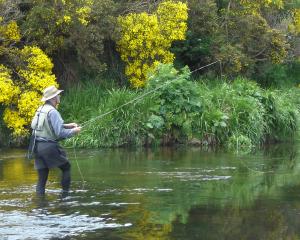
Most rivers are either rising or falling at the moment. Those that are rising will take a week or so to get to a good fishable level, provided there is no more rain. Those that are falling will not be fishable for three or four days with the same rain proviso.
However, the Waipahi is the odd river out. It is still low as I write and should be fishable this weekend.
With some rain in its catchment, it may be slightly discoloured but definitely fishable. It is one of the rivers we can expect a hatch of mayflies from late morning and into the afternoon and even a sedge hatch in the evening.
The lower Leith is also worth a cast. Any sea trout that are preparing to run the Leith to spawn gather there waiting for enough water to get them to the redds. Most years some big fish are caught where it runs into the harbour.
So, all is not lost for those preferring to fish flowing water.
The alternative is to fish a still water, which opens up plenty of options such as the Maniototo dams, as well as those in Central Otago.
The large southern lakes also fish well around mouths of tributaries especially for rainbows. Brown trout can be found cruising the shallows early in the day feeding on snails and midge.
I fished Blakely’s Dam recently on a fine day with little wind but not many were fish rising. As usual I fished several spots where I have caught fish before but with only one take in a couple of hours.
I did notice several rises in one spot so headed in that direction. I approached cautiously as it was sunny and the water was clear and shallow.
A fish appeared from behind some reeds. I cast a short distance ahead of it and gave the flies a twitch and it picked out the damsel fly nymph. It was a nice 2kg fish in fine condition.
Wandering around I ended up on the dam where there were odd rises well out which seemed to be made by good sized fish. In the past I have caught good fish there using a lead eyed damsel fly nymph. So, I tied one on and heaved it out.
They are not easy to cast hence the heave. I gave it a while to sink and started a slow retrieve. It is necessary to retrieve slowly to keep the fly deep.
On the third heave I had just begun the retrieve when something solid made contact with the fly. I set the hook and the fish took off exploding from the water. After a while it tired and came to the net and at 4kg was my best Blakely’s fish of the season.


